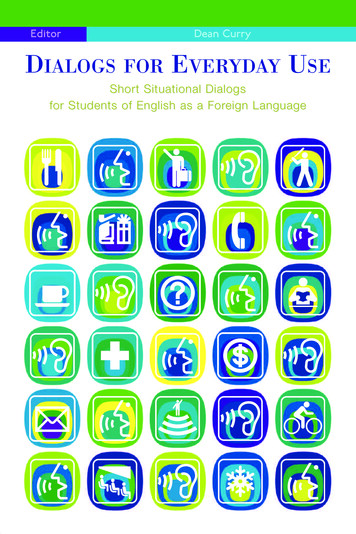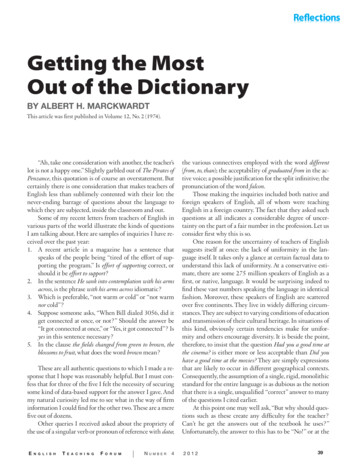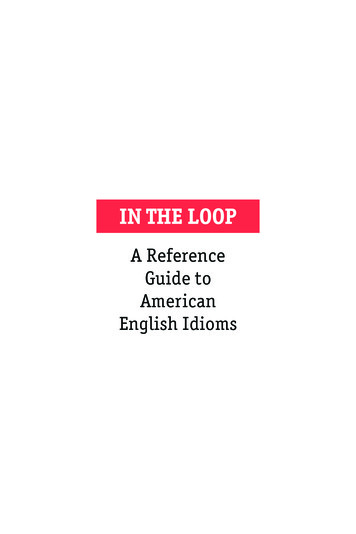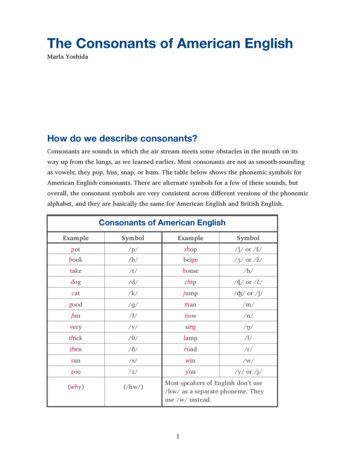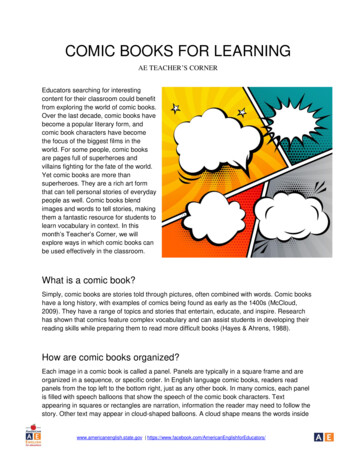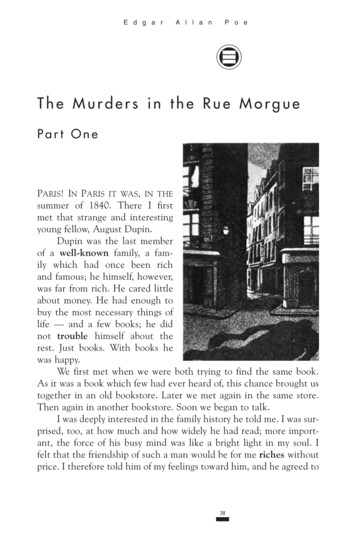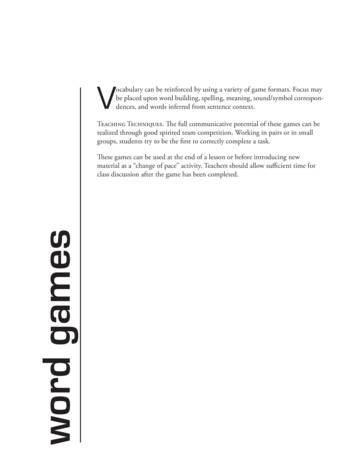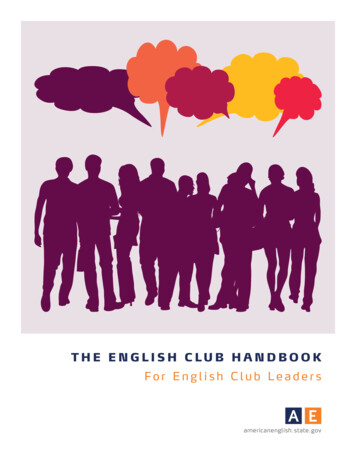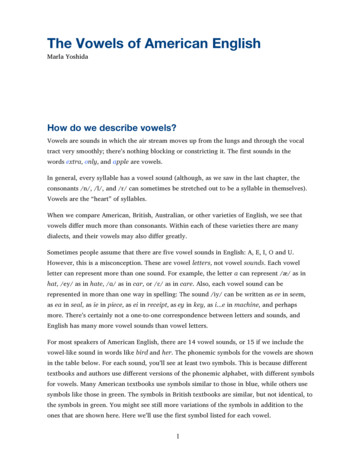
Transcription
The Vowels of American EnglishMarla YoshidaHow do we describe vowels?Vowels are sounds in which the air stream moves up from the lungs and through the vocaltract very smoothly; there’s nothing blocking or constricting it. The first sounds in thewords extra, only, and apple are vowels.In general, every syllable has a vowel sound (although, as we saw in the last chapter, theconsonants /n/, /l/, and /r/ can sometimes be stretched out to be a syllable in themselves).Vowels are the “heart” of syllables.When we compare American, British, Australian, or other varieties of English, we see thatvowels differ much more than consonants. Within each of these varieties there are manydialects, and their vowels may also differ greatly.Sometimes people assume that there are five vowel sounds in English: A, E, I, O and U.However, this is a misconception. These are vowel letters, not vowel sounds. Each vowelletter can represent more than one sound. For example, the letter a can represent /æ/ as inhat, /ey/ as in hate, /ɑ/ as in car, or /ɛ/ as in care. Also, each vowel sound can berepresented in more than one way in spelling: The sound /iy/ can be written as ee in seem,as ea in seal, as ie in piece, as ei in receipt, as ey in key, as i.e in machine, and perhapsmore. There’s certainly not a one-to-one correspondence between letters and sounds, andEnglish has many more vowel sounds than vowel letters.For most speakers of American English, there are 14 vowel sounds, or 15 if we include thevowel-like sound in words like bird and her. The phonemic symbols for the vowels are shownin the table below. For each sound, you’ll see at least two symbols. This is because differenttextbooks and authors use different versions of the phonemic alphabet, with different symbolsfor vowels. Many American textbooks use symbols similar to those in blue, while others usesymbols like those in green. The symbols in British textbooks are similar, but not identical, tothe symbols in green. You might see still more variations of the symbols in addition to theones that are shown here. Here we’ll use the first symbol listed for each vowel.1
Vowels of American t/ʌ//ə/by/ay/ /ai/ /aɪ/sofa/ə//ə/cow/aw/ /au/ /aᴜ/her/ɚ/ /ɝ/ /ər/ /ɜr/boy/oy/ /ɔy/ /ɔi/ /ɔɪ//ou/Describing vowels is trickier than describing consonants. The tongue is floating freelyaround the mouth, not touching other parts of the vocal tract. This makes it harder todescribe exactly what’s happening in the mouth. When we describe the vowels of English,we traditionally talk about: Tongue position Lip rounding Tense and lax vowels Simple vowels, glided vowels, and diphthongsThese categories are not as precise or reliable as those we use to describe consonants. Someof them are not even as firmly based on physical reality as we like to think, and they canvary a great deal among individual speakers. Still, the descriptions are useful in teaching,and it’s important for teachers to know how vowels are traditionally described.Tongue positionThe way we move and shape our tongue plays a big part in giving each vowel its ownsound. When you pronounce a vowel, even a small change in the position of your tonguecan make a big difference in how the vowel sounds.When we talk about tongue position, we mean: Where is the highest, tensest, or most activepart of the tongue? The way we describe this position is something like graphing a point inmath or finding a location on a map. We give two “coordinates” to describe where the point2
is, like the x and y coordinates of a point on a graph or a location on a map.In describing a vowel, we list the vertical position of the tongue first: high, mid, or low.That is, is the tongue raised toward the top of the mouth, or farther down with a more openjaw? Then we name its horizontal position: front, central, or back. A description of thetongue position for vowels tells both of these “coordinates.” For example: /æ/ as in cat is a low front vowel. The most active part of the tongue is in the lowerfront part of the mouth. /ʌ/ as in cut is a mid central vowel. The tongue is resting in the middle of themouth in a very neutral position. /uw/ as in boot is a high back vowel. The back of the tongue is bunched up high atthe back of the mouth.We can show the tongue positions for different vowels by using a diagram called a vowelquadrant. This chart is divided into nine sections, each representing a different tongueplacement, vertically and horizontally. The diagrams below show two versions of the vowelquadrant. The first shows the vowel quadrant alone, and the second shows how the sectionsof the vowel quadrant are related to the parts of the vocal tract.3
Vowels that are near each other in the vowel quadrant are pronounced with tonguepositions that are close to each other and their sounds are similar, so learners are morelikely to confuse them than pairs that are farther apart in the vowel quadrant. For example,learners often confuse sheep (/iy/) and ship (/ɪ/), whose vowels are in adjacent boxes, butthey seldom confuse sheep and shop (/ɑ/), which are farther apart.We can also use sagittal section diagrams, or “Sammy” diagrams, to show tonguepositions for vowels. The diagrams at the end of this section show tongue positions for thevowels of English.Lip roundingVowel sounds are also affected by the shape of the lips—whether they’re very rounded, justa little rounded, relaxed, or stretched a bit wide.In English, the back vowels, /uw/, /ᴜ/, /ow/, and /ɔ/, are pronounced with varyingdegrees of lip rounding, and /r/ also has a little lip rounding, whether it’s used as aconsonant (/r/) or a vowel (/ɚ/). The front and central vowels—/iy/, /ɪ/, /ey/, /ɛ/, /æ/,/ʌ/, /ə/, and /ɑ/—are unrounded. For the vowels /iy/ and /ɪ/, the lips may be spread orstretched a bit wide, and some textbooks even tell students to “smile” when they say thevowels in heat or hit. The table on the next page shows typical lip positions for AmericanEnglish vowels.In reality, however, the lip positions that native speakers use for vowel sounds vary quite abit. Some people don’t move their lips much, and others move their lips much more. Theirlip positions may not look just like those in the chart, but they can still produce perfectlynormal vowel sounds. Still, knowing and imitating these “standard” lip positions can helpstudents to pronounce vowel sounds more understandably.4
Lip positions for the vowels of EnglishVowelLip PositionPicture/iy/Unrounded, can be stretched a bit/ɪ/Unrounded, can be stretched a bit/ey/Unrounded, not so stretched/ɛ/Unrounded, not so stretched/æ/Unrounded, open wide/ɑ/Unrounded, open wide/ʌ/, /ə//uw//ᴜ//ow/Unrounded, neutral and relaxedVery roundedModerately roundedRounded at the end of the vowel/ɔ/Open and a bit rounded/ɚ/A bit rounded/ay/Unrounded unrounded /aw/Unrounded rounded /oy/Rounded unrounded Tense and lax vowelsWe can also divide vowels into two categories called tense and lax vowels. This is adistinction that separates pairs of vowels like those in sheep (/iy/) and ship (/ɪ/), late(/ey/) and let (/ɛ/), fool (/uw/) and full (/ᴜ/). We traditionally think of these as being adifference in the tension or tightness of the muscles of the tongue or lips while saying thesound, but again, this is an oversimplification. There is sometimes not a great difference inphysical tension of tense and lax vowels. (Ladefoged, 2006)5
Which vowels are in each group? The vowel quadrant below shows the tense vowels in redand the lax vowels in blue. If you look at the dotted line that divides the two groups, youcan see that the tense vowels are mostly toward the outside edges of the quadrant,indicating that they have more extreme tongue positions, and the tongue has to stretch orpush a bit farther to get there. The lax vowels are closer to the middle of the quadrant; thetongue is not pushing out toward the extreme edges of the mouth, so in a sense, it is morerelaxed.Another difference between tense and lax vowels in in the positions in which they can beused in words. Tense vowels can occur both in closed syllables (those that end in aconsonant sound, like meet or goal) and open syllables (those that do not have aconsonant sound after the vowel, like me or go.) Lax vowels can occur in closed syllables,but not in stressed, open syllables. This means that we often find words that end in tensevowels: Me, day, shoe, show, saw, happy, today, subdue, etc. However, we never findwords that end in lax vowels. That is, English doesn’t have words like /mɪ/, /dɛ/, /ʃæ/, or/bᴜ/.Simple vowels, glided vowels, and diphthongsFinally, we can classify vowels based on how much tongue movement there is during thevowel. For example, when we say /æ/ as in bad, the tongue position and quality of thevowel stay constant throughout the sound, even if we continue to say the vowel for a longtime. We call this type of vowel a simple vowel or a pure vowel.Other vowels have a small change in tongue position from the beginning to the end. Forexample, when we say /ey/ as in day, our tongue moves just a bit, from the position of /ɛ/to the position of /iy/. We can call vowels of this type glided vowels or vowels withglides. (In some textbooks, glided vowels aren’t considered a separate group. Some authors6
include them with the simple vowels, while others group them together with thediphthongs.)It may be difficult to hear the difference between the simple vowels and glided vowelswhen someone is speaking at a normal speed, but when you say the vowels slowly, youshould be able to hear and feel the change in tongue position. In particular, it’s the slightglide at the end of /ey/ and /ow/ that makes them sound different from /e/ or /o/-typevowels in many other languages.Finally, some vowels have a big change in tongue position and sometimes also in liprounding from the beginning to the end of the sound. For example, /ay/ as in buy soundslike a combination of the vowels /ɑ/ and /iy/ blended together, with the first part longerand more prominent, and the second part lasting a shorter time than the first. We call thesevowels diphthongs. The vowel quadrant shown below illustrates the diphthongs bydrawing arrows from the beginning to the ending tongue positions for each one.In addition to the change in tongue position, the diphthongs /aw/ and /oy/ also have achange in lip rounding; /aw/ begins with unrounded lips and changes to rounded lips, and/oy/ moves from rounded to unrounded.The glided vowels and diphthongs in American English all end in the glides /y/ or /w/.We’ve already seen glides as a category of consonants, which are also called semivowels.We can see now why they have this name, which means “half-vowel.” They sound likequick vowels, but function as either vowels or consonants, depending on the context.The vowel /ɚ /There is one more vowel-like sound in English: /ɚ/. This is the sound in words like bird,first, and her. In many textbooks this sound is analyzed as a combination of a vowel plus a7
consonant, and represented by the symbols /ər/, /ɜr/, /ər/, or /ɜr/. In others, it’srepresented by a single symbol, /ɚ/. Whichever symbols we use, this sound is best thoughtof as a single vowel sound, rather than a vowel sound followed by a consonant. The onlydifference between the vowel /ɚ/ and the consonant /r/ is in timing: /ɚ/ lasts longer sothat it becomes the “heart” of the syllable.There is actually more than one way to pronounce the /ɚ/ sound. Some people pronounceit with the tip of the tongue curled back a bit. In fact, the /r/ and /ɚ/ sounds are oftencalled retroflex sounds, a name that comes from a Latin word meaning “bent backward.”However, other people pronounce /r/ and /ɚ/ with the back of the tongue bunched up atthe back, without curling the tip. Both ways can produce the same sound. With both tonguepositions, the lips are slightly rounded./r/ with the tongue curled/r/ with the tongue pulled backAn endangered vowel sound: /ɔ/Languages and their sounds are changing all the time. One change that is happening now inAmerican English involves the vowel sound /ɔ/. For many speakers, the vowel /ɔ/ ismerging with /ɑ/. This means that these speakers pronounce words that are listed in mostdictionaries with the vowel /ɔ/, like caught, saw, and walk, with an /ɑ/ sound instead. Socaught and cot sound alike: /kɑt/, and dawn and don sound alike: /dɑn/.The merging of /ɔ/ and /ɑ/ is occurring mainly in the Western and Midwestern areas of theUnited States and is more common among younger speakers than older speakers (Ladefoged2005, p. 28). We might say that in many areas of the United States, /ɔ/ is an “endangeredsound.” As time goes by, it’s being used less and less in some words, and may eventually dieout as a separate phoneme.Because of this merging of sounds, for teaching purposes it’s much less important to teachthe difference between /ɔ/ and /ɑ/ than it is to teach the difference between, for example,/ɑ/ and /æ/. If students pronounce cot and caught the same way, they’ll be understood, but8
if they pronounce cot and cat in the same way, people will be confused.“Invisible /y/”Learners sometimes have trouble knowing how to pronounce words spelled with the vowelletters u, ue, eu, ew, or ui. In American English, these letters sometimes represent the sound/uw/, as in the words suit (/suwt/) or true (/truw/), and sometimes /yuw/, as in the wordsmusic (/myuwzɪk/), computer (/kəmpyuwtɚ/), and pew (/pyuw/). In some words spelledwith these letters, the vowel sound can even be pronounced either way, such as new(/nuw/ or /nyuw/). What’s happening here?We sometimes say that the /yuw/ pronunciation in words like this has an “invisible /y/”because we hear a /y/ sound, but it’s not represented in spelling. We might think of /yuw/as another diphthong, but with the glide at the beginning instead of the end.In standa
English has many more vowel sounds than vowel letters. For most speakers of American English, there are 14 vowel sounds, or 15 if we include the vowel-like sound in words like bird and her. The phonemic symbols for the vowels are shown in the table below. For each sound, you’ll see at least two symbols. This is because differentFile Size: 1MBPage Count: 15


